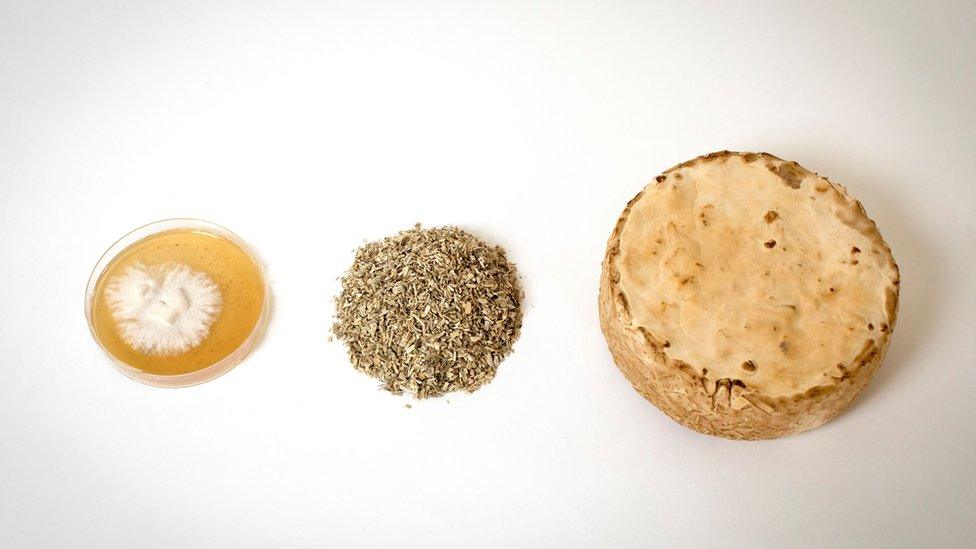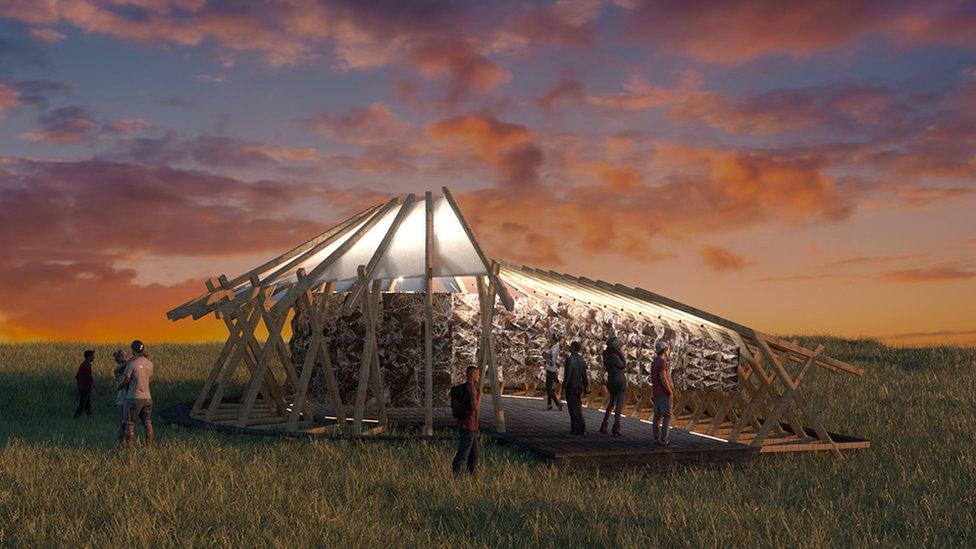Glastonbury Festival: The mushroom-root pavilion at Silver Hayes
- Published

People from film, TV and educational institutes have worked on the project including biomaterials specliast Leksi Kostur(bottom left) and the projects design innovation lead Simon Carroll (top second from left)
A new pavilion, made with mushroom roots, has been set up at Glastonbury Festival.
The Silver Hayes team has unveiled the 6° project and aims to investigate how roots can be used more in creative industries.
The Hayes Pavilion, shaped like the number six, represents how people are connected to each other.
Project lead Ben Price said: "Festivals are micro cities - what's done on this scale can give an insight on society."
The Hayes Pavilion marks the 10th anniversary and evolution of Silver Hayes, an area at the festival which hosts electronic music and emerging performers.
Glastonbury will be one of the first music festivals with a pavilion made with the biomaterial, mycelium.
With timber frames supporting the pavilion, its renders are made from mycelium - the root part of fungi.
Simon Carroll, the projects design innovation lead, first approached Mr Price about the capabilities of mycelium in the creativity industry many years ago.

The pavilion has been set up to mark the 10th anniversary of Silver Hayes at Glastonbury Festival
"Mycelium roots have hundreds of different strains, but we have chosen a particular strain that works well when you bind it with agricultural waste," Mr Price said.
"But in the future this could be used with other types of waste like plastic."
Creative practitioners involved in film, television and set design as well as educational institutes worked on the project.

The three stages of the mycelium's growing process
Mr Price said mycelium has the potential to have a big impact within the creative industry.
"Everyone is connected to each other much like mycelium is a connection of the roots of mushrooms underground. People don't know the power that this material has in our industry - it has the potential to change society in many ways," he said.
"A lot of big musicians that have gone on to play at the big stages at Glastonbury first performed at Silver Hayes. We wanted to mirror that with our ideas."

The venue has been made out of mushroom roots
An ongoing research project involves finding out how long the pavilion can be preserved, as mycelium is biodegradable.
The Silver Hayes' team says it is aware of the negative impact festivals have to climate change, such as excessive waste, but wants to make a change.
The sustainability lead of the project, Pauline Bourdon, said: "What is different with festivals and the mycelium project is the potential to discover and to test new behaviours.
"When you push together new ideas and the wonderful feeling of being together - that sense of community and music - you can then push a lot of social and climate awareness."

In the lead up to the installation, the mycelium has been tested, manipulated and challenged to find out what is possible
The pavilion will showcase findings through an exhibition - giving evidence on how mycelium can replace polystyrene and plastics in the festival industry.
A documentary will be released at the end of the project, following Glastonbury Festival.
The mycelium pavilion will host to immersive sound art compositions by academic and musician Brian d'Souza (Auntie Flo) and Manchester rising star Or:La.
Project 6° will be open to festival goers from 22 to 25 June.

Follow BBC West on Facebook, external, Twitter, external and Instagram, external. Send your story ideas to: bristol@bbc.co.uk
- Published19 March 2023

- Published30 May 2022

- Published23 June 2019
